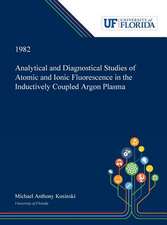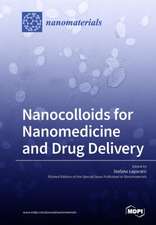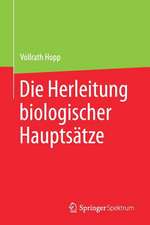Freshney′s Culture of Animal Cells – A Manual of Basic Technique and Specialized Applications, 8th Edition
Autor A Capes–Davisen Limba Engleză Hardback – 12 mai 2021
Preț: 628.90 lei
Preț vechi: 827.49 lei
-24% Nou
Puncte Express: 943
Preț estimativ în valută:
120.38€ • 130.80$ • 101.18£
120.38€ • 130.80$ • 101.18£
Carte disponibilă
Livrare economică 31 martie-14 aprilie
Livrare express 14-20 martie pentru 88.18 lei
Preluare comenzi: 021 569.72.76
Specificații
ISBN-13: 9781119513018
ISBN-10: 1119513014
Pagini: 832
Dimensiuni: 222 x 289 x 45 mm
Greutate: 2.22 kg
Ediția:8th Edition
Editura: Wiley
Locul publicării:Chichester, United Kingdom
ISBN-10: 1119513014
Pagini: 832
Dimensiuni: 222 x 289 x 45 mm
Greutate: 2.22 kg
Ediția:8th Edition
Editura: Wiley
Locul publicării:Chichester, United Kingdom
Cuprins
Foreword xix
Acknowledgments xxi
Abbreviations xxiii
Book Navigation xxix
Part I Understanding Cell Culture 1
1. Introduction 3
1.1 Terminology 3
1.2 Historical Development 4
1.3 Applications 12
1.4 Advantages of Tissue Culture 13
1.5 Limitations of Tissue Culture 15
References 18
2. Biology of Cultured Cells 23
2.1 The Culture Environment 23
2.2 Cell Adhesion 23
2.3 Cell Division 28
2.4 Cell Fate 30
2.5 Cell Death 35
References 36
3. Origin and Evolution of Cultured Cells 39
3.1 Origin of Cultured Cells 39
3.2 Evolution of Cell Lines 40
3.3 Changes in Genotype 43
3.4 Changes in Phenotype 46
3.5 Senescence and Immortalization 48
Minireview M3.1 Senescence and Immortalization 48
3.6 Transformation 50
3.7 Conclusions: Origin and Evolution 58
References 58
Part II Laboratory and Regulatory Requirements 63
4. Laboratory Design and Layout 65
4.1 Design Requirements 65
4.2 Layout of Laboratory Areas 74
4.3 Disaster and Contingency Planning 80
References 83
5. Equipment and Materials 85
5.1 Sterile Handling Area Equipment 85
5.2 Imaging and Analysis Equipment 97
5.3 Incubation Equipment 99
5.4 Preparation and Washup Equipment 104
5.5 Cold Storage Equipment 107
References 109
6. Safety and Bioethics 111
6.1 Laboratory Safety 111
6.2 Hazards in Tissue Culture Laboratories 117
6.3 Biosafety 121
6.4 Bioethics 129
References 132
7. Reproducibility and Good Cell Culture Practice 137
7.1 Reproducibility 137
7.2 Good Practice Requirements 141
7.3 Cell Line Provenance 145
7.4 Validation Testing 146
7.5 Quality Assurance (QA) 148
7.6 Replicate Sampling 150
References 151
Part III Medium and Substrate Requirements 155
8. Culture Vessels and Substrates 157
8.1 Attachment and Growth Requirements 157
8.2 Substrate Materials 158
8.3 Substrate Treatments 159
8.4 Feeder Layers 163
8.5 Choice of Culture Vessel 164
8.6 Application-Specific Vessels 170
References 173
9. Defined Media and Supplements 177
9.1 Medium Development 177
9.2 Physicochemical Properties 177
9.3 Balanced Salt Solutions 185
9.4 Media Formulations 186
9.5 Serum 189
9.6 Other Media Supplements 191
9.7 Choice of Complete Medium 191
9.8 Storage of Medium and Serum 194
Suppliers 194
References 194
10. Serum-Free Media 199
10.1 Rationale for Serum-Free Medium 199
10.2 Development of Serum-Free Medium 201
10.3 Serum-Free Media Formulations 202
10.4 Serum-Free Supplements 203
10.5 Serum Replacements 209
10.6 Use of Serum-Free Medium 209
10.7 Xeno-Free Media 213
10.8 Animal Product-Free Media 214
10.9 Conclusions: Serum-Free Media 214
Suppliers 214
References 215
11. Preparation and Sterilization 219
11.1 Terminology: Preparation 219
11.2 Sterilization Methods 220
11.3 Glassware 224
Protocol P11.1 Preparation and Sterilization of Glassware 224
11.4 Other Laboratory Apparatus 229
11.5 Water 229
11.6 Media and Other Reagents 233
11.7 Sterile Filtration 238
11.8 Medium Testing 242
Suppliers 247
References 247
Part IV Handling Cultures 249
12. Aseptic Technique 251
12.1 Objectives of Aseptic Technique 251
12.2 Elements of Aseptic Environment 252
12.3 Sterile Handling 258
12.4 Good Aseptic Technique 260
12.5 Controlling Equipment Contamination 265
Suppliers 267
References 267
13. Primary Culture 269
13.1 Rationale for Primary Culture 269
13.2 Initiation of Primary Culture 270
13.3 Tissue Acquisition and Isolation 274
13.4 Primary Explantation 281
Protocol P13.3 Culture of Primary Explants 281
13.5 Enzymatic Disaggregation 283
13.6 Mechanical Disaggregation 290
Protocol P13.7 Mechanical Disaggregation by Sieving 291
13.7 Enrichment of Viable Cells 292
Protocol P13.8 Enrichment of Viable Cells 292
13.8 Record Keeping for Primary Culture 293
13.9 Conclusions: Primary Culture 294
Suppliers 294
References 294
14. Subculture and Cell Lines 297
14.1 Terminology: Cell Line and Subculture 297
14.2 Initiating a Cell Line 298
14.3 Choosing a Cell Line 300
14.4 Maintaining a Cell Line 304
14.5 Replacing Medium (Feeding) 309
14.6 Subculture (Passaging) 312
14.7 Maintaining Suspension Cultures 320
14.8 Serum-Free Subculture 322
14.9 Record Keeping for Cell Lines 323
Suppliers 324
References 325
15. Cryopreservation and Banking 327
15.1 Principles of Cryopreservation 327
15.2 Apparatus for Cryopreservation 329
15.3 Requirements for Cryopreservation 335
15.4 Cryopreservation Procedures 336
15.5 Cell Banking Procedures 341
15.6 Cell Repositories 342
15.7 Record Keeping for Frozen Stocks 345
15.8 Transporting Cells 347
Suppliers 348
References 348
Part V Validation and Characterization 351
16. Microbial Contamination 353
16.1 Sources of Contamination 353
16.2 Management of Contamination 359
Protocol P16.1 Disposal of Contaminated Cultures 360
16.3 Visible Microbial Contamination 361
16.4 Mycoplasma Contamination 364
16.5 Viral Contamination 373
16.6 Dealing with Persistent Contamination 376
Suppliers 376
References 376
17. Cell Line Misidentification and Authentication 381
17.1 Terminology: Cross-Contamination, Misidentification, and Authentication 381
17.2 Misidentified Cell Lines 382
17.3 Cell Line Authentication 386
17.4 Authentication of Challenging Samples 401
17.5 Conclusions: Authentication 403
Suppliers 403
References 403
18. Cell Line Characterization 409
18.1 Priorities and Essential Characterization 409
18.2 Genotype-Based Characterization 416
18.3 Phenotype-Based Characterization 419
18.4 Cell Imaging 423
18.5 Cell Staining 428
Suppliers 430
References 430
19. Quantitation and Growth Kinetics 437
19.1 Cell Counting 437
19.3 Cell Proliferation 450
19.4 Cloning Efficiency 456
19.5 DNA Synthesis 460
19.6 Cell Cycle Analysis 461
Suppliers 461
References 461
Part VI Physical and Genetic Manipulation 465
20. Cell Cloning and Selection 467
20.1 Terminology: Cloning and Selection 467
20.2 Cloning by Limiting Dilution 468
20.3 Cloning in Suspension 473
20.4 Selection of Clones 477
20.5 Replica Plating 480
20.6 Stimulation of Cloning Efficiency 481
20.7 Selective Culture Conditions 485
20.8 Conclusions: Cloning and Selection 487
Suppliers 487
References 487
21. Cell Separation and Sorting 491
21.1 Cell Density and Isopycnic Centrifugation 491
21.2 Cell Size and Sedimentation Velocity 495
21.3 Magnetic Separation and Sorting 496
Protocol P21.2 Magnet-Activated Cell Sorting (MACS) 499
21.4 Fluorescence-Activated Cell Sorting (FACS) 500
21.5 Microfluidic Sorting 502
Minireview M21.1 Microfluidic Cell Culture 503
21.6 Conclusions: Sorting and Separation 505
Suppliers 505
References 505
22. Genetic Modification and Immortalization 509
22.1 Gene Delivery 509
22.2 Gene Editing 517
22.3 Immortalization 523
22.4 Screening and Artifacts 526
Suppliers 528
References 528
Part VII Stem Cells and Differentiated Cells 535
23. Culture of Stem Cells 537
23.1 Terminology: Stem Cells 537
23.2 Embryonic Stem Cells (ESCs) 540
23.3 Induction of Pluripotency 545
Protocol P23.1 Generation of iPSCs Using Sendai Viral Vectors 547
23.4 Human Pluripotent Stem Cell (hPSC) Lines 549
23.5 Perinatal Stem Cells 556
23.6 Adult Stem Cells 557
23.7 Stem Cell Characterization and Banking 558
23.8 Conclusions: Culture of Stem Cells 560
Suppliers 561
References 561
24. Culture of Specific Cell Types 567
24.1 Specialized Cells and Their Availability 567
24.2 Epithelial Cells 572
24.3 Mesenchymal Cells 577
24.4 Neuroectodermal Cells 580
24.5 Hematopoietic Cells 581
24.6 Culture of Cells from Poikilotherms 585
Suppliers 587
References 587
25. Culture of Tumor Cells 593
25.1 Challenges of Tumor Cell Culture 593
25.2 Primary Culture of Tumor Cells 594
25.3 Development of Tumor Cell Lines 596
25.4 Selective Culture of Tumor Cells 599
25.5 Specific Tumor Types 603
25.6 Cancer Stem Cells (CSCs) 606
Minireview M25.1 Culture of Cancer Stem Cells 606
Suppliers 608
References 608
26. Differentiation 615
26.1 In Vitro Models of Differentiation 615
26.2 Differentiation Status in Culture 617
26.3 Induction of Differentiation 620
26.4 Practical Aspects 628
26.5 Ongoing Challenges 629
Suppliers 631
References 631
Part VIII Model Environments and Applications 639
27. Three-Dimensional Culture 641
27.1 Terminology: 3D Culture 641
27.2 Technologies for 3D Culture 643
Minireview M27.1 Advances in Technologies Enabling 3D Cell Culture and the Formation of Tissue-Like Architecture In Vitro 643
27.3 Benefits and Limitations of 3D Culture 646
27.4 Scaffold-Free 3D Culture Systems 647
27.5 Scaffold-Based 3D Culture Systems 652
27.6 Organoid Culture 659
27.7 Organotypic Culture 660
27.8 Organ Culture 662
27.9 Characterization of 3D Cultures 662
Suppliers 663
References 663
28. Scale-Up and Automation 669
28.1 Terminology: Scale-Up and Bioreactors 669
28.2 Scale-Up in Suspension 671
28.3 Scale-Up in Monolayer 677
28.4 Monitoring and Process Control 685
28.5 Scale-Up for Manufacture 688
Minireview M28.1 Culture Scale-Up and Bioreactors 688
28.6 High-Throughput Screening 691
28.7 Automation and Bioprinting 691
Suppliers 696
References 696
29. Toxicity Testing 701
29.1 In Vitro Toxicity Testing 701
29.2 Cytotoxicity Assays 704
29.3 Genotoxicity Assays 715
29.4 Carcinogenicity Assays 716
29.5 Advanced Models for Toxicity Testing 716
Suppliers 719
References 719
Part IX Teaching and Troubleshooting 725
30. Training 727
30.1 Training Principles 727
30.2 Training Programs 729
References 731
31. Problem Solving 733
31.1 Microbial Contamination 733
31.2 Cross-Contamination and Misidentification 737
31.3 Chemical Contamination 738
31.4 Slow Cell Growth 738
31.5 Abnormal Cell Appearance 740
31.6 Problems with Materials 741
31.7 Problems with Primary Culture 744
31.8 Problems with Feeding or Subculture 746
31.9 Problems with Cryopreservation 748
31.10 Problems with Cloning 750
References 752
32. In Conclusion 753
Appendix A Glossary 755
Appendix B Calculations and Preparation of Reagents 761
Calculations 761
Counting Cells with a Hemocytometer 761
Dilution of a Cell Suspension 761
Population Doubling Level (PDL) 761
Molarity 762
Percentages and Dilutions 762
Pressure 762
Rotor Speed (rpm to g) 762
Preparation of Reagents 762
Acetic Acid: Methanol 762
Agar (2.5%) 762
Alcohol (70%) 762
Bacto(TM) Peptone (5%) 763
Balanced Salt Solutions 763
Carboxymethylcellulose (CMC; 4%) 763
Chick Embryo Extract 763
Collagenase 763
Collection Medium 763
Crystal Violet (0.1%) 764
Dexamethasone (1 mg/ml) 764
Dissection Balanced Salt Solution (DBSS) 764
Dulbecco's Phosphate-Buffered Saline Without Ca2+ and Mg2+ (DPBS-A) 764
EDTA (10 mM in DPBS-A) 764
EGTA 764
Erythrosin B 764
Gelatin (1%) 765
Giemsa Stain 765
Glucose (20%) 765
Glutamine 200 mM 765
Hanks's Balanced Salt Solution (HBSS) 765
HAT Medium 765
HB Medium 765
HEPES 765
Hoechst 33258 766
Media 766
2-Mercaptoethanol (beta-Mercaptoethanol; 0.1 M) 766
Methylcellulose (Methocel, 1.6%) 766
Mitomycin C (100 mug/ml) 766
MTT (50 mg/ml) 766
N2 Supplement 766
N2B27 Medium 767
Naphthalene Black (Amido Black; 1%) 767
Non-essential Amino Acids (NEAA, 100×) 767
Paraformaldehyde (4%) 767
Trypan Blue (0.4%) 767
Trypsin (2.5%) 768
Versene 768
Suppliers 768
References 768
Appendix C Media Formulations 769
References 779
Index 781
Notă biografică
AMANDA CAPES-DAVIS, PHD, is a cell culture scientist and technical writer. She was Founding Manager and Honorary Scientist at CellBank Australia, Children's Medical Research Institute (CMRI), and is a member of the International Cell Line Authentication Committee (ICLAC). She was a Reviewing Editor for the 7th edition of Culture of Animal Cells, and has written numerous journal articles, policies, protocols, and white papers on good cell culture practice. R. IAN FRESHNEY, PHD, was an honorary Senior Research Fellow at the Institute of Cancer Sciences at the University of Glasgow, UK. Dr Freshney, who died in 2019, was a world-renowned cancer biologist and a pioneer in cell culture techniques who made important contributions to new approaches for treating cancer patients. He taught cell culture courses at national and international level, and wrote and edited numerous books, including the first seven editions of Culture of Animal Cells.















